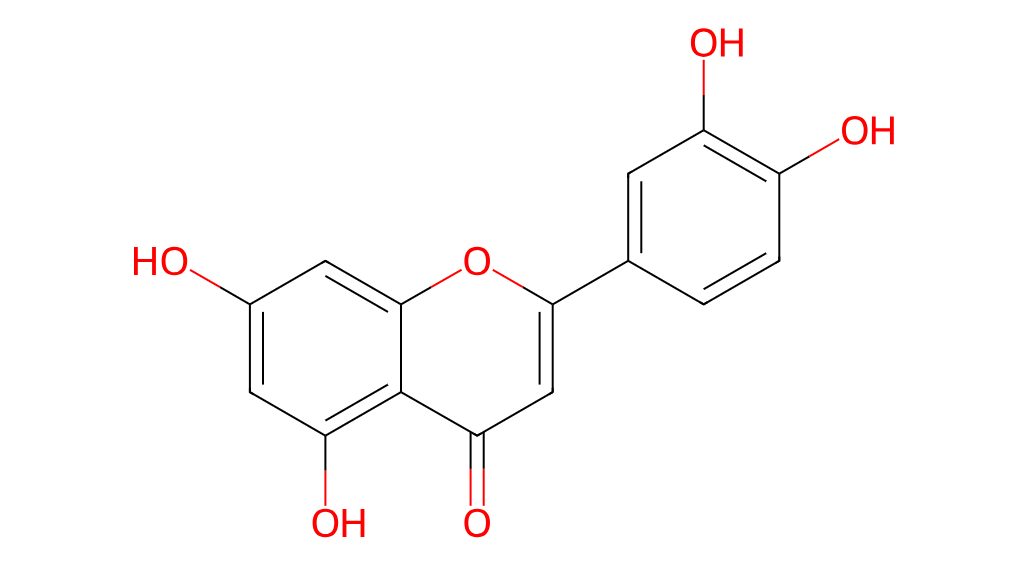Luteolin CAS#: 491-70-3; ChemWhat Code: 52504
Identification
| Product Name | Luteolin |
| IUPAC Name | 2-(3,4-dihydroxyphenyl)-5,7-dihydroxychromen-4-one |
| Molecular Structure |  |
| CAS Registry Number | 491-70-3 |
| EINECS Number | 207-741-0 |
| MDL Number | MFCD00017309 |
| Beilstein Registry Number | 292084 |
| Synonyms | 2-(3,4-Dihydroxy-phenyl)-5,7-dihydroxy-chromen-4-onluteolin3′,4′,5,7-tetrahydroxyflavone3′,4′,5,7-tetrahydroxyflavoneluteoline5,7,3′,4′-tetrahydroxyflavone2-(3,4-dihydroxyphenyl)-5,7-dihydroxy-4H-chromen-4-one |
| Molecular Formula | C15H10O6 |
| Molecular Weight | 286.241 |
| InChI | InChI=1S/C15H10O6/c16-8-4-11(19)15-12(20)6-13(21-14(15)5-8)7-1-2-9(17)10(18)3-7/h1-6,16-19H |
| InChI Key | IQPNAANSBPBGFQ-UHFFFAOYSA-N |
| Canonical SMILES | O=c1cc(-c2ccc(O)c(O)c2)oc2cc(O)cc(O)c12 |
| Patent Information | ||
| Patent ID | Title | Publication Date |
| WO2025/90994 | NEW BENZAMIDE DERIVATIVES AS PPAR-GAMMA MODULATORS | 2025 |
Physical Data
| Appearance | Light yellow Powder |
| Solubility | No data available |
| Flash Point | No data available |
| Refractive index | No data available |
| Sensitivity | No data available |
| Melting Point, °C | Solvent (Melting Point) |
| 227 – 229 | |
| 321 – 328 | |
| 327 – 329 | methanol |
| 289 – 291 |
| Boiling Point, °C |
| 326 |
| Description (Association (MCS)) | Solvent (Association (MCS)) | Partner (Association (MCS)) |
| Adsorption isotherm | acetonitrile, water | 1,3,5-tris(4-aminophenyl)benzene, 2,5-dihydroxyterephthalaldehyde based covalent organic framework |
| Adsorption isotherm | acetonitrile, water | AB-8 macroporous resin |
| Adsorption isotherm | acetonitrile, water | D101 macroporous resin |
| Desorption | tetrahydrofuran | 1,3,5-tris(4-aminophenyl)benzene, 2,5-dihydroxyterephthalaldehyde based covalent organic framework |
| Desorption | methanol | 1,3,5-tris(4-aminophenyl)benzene, 2,5-dihydroxyterephthalaldehyde based covalent organic framework |
| Desorption | ethanol | 1,3,5-tris(4-aminophenyl)benzene, 2,5-dihydroxyterephthalaldehyde based covalent organic framework |
Spectra
| Description (NMR Spectroscopy) | Nucleus (NMR Spectroscopy) | Solvents (NMR Spectroscopy) | Frequency (NMR Spectroscopy), MHz |
| Chemical shifts | 1H | dimethylsulfoxide-d6 | 500 |
| Chemical shifts | 13C | dimethylsulfoxide-d6 | 600 |
| Chemical shifts | 13C | dimethylsulfoxide-d6 | 150 |
| Chemical shifts, Spectrum | 1H | dimethylsulfoxide-d6 | 600 |
| Description (IR Spectroscopy) | Solvent (IR Spectroscopy) |
| Bands, Spectrum | potassium bromide |
| Spectrum | |
| Bands, Spectrum | |
| Bands | potassium bromide |
| Description (Mass Spectrometry) |
| liquid chromatography mass spectrometry (LCMS), IT (ion trap), electrospray ionisation (ESI), spectrum |
| spectrum |
| liquid chromatography mass spectrometry (LCMS), spectrum |
| liquid chromatography mass spectrometry (LCMS), electrospray ionisation (ESI), time-of-flight mass spectra (TOFMS), spectrum |
| liquid chromatography mass spectrometry (LCMS), electrospray ionisation (ESI), tandem mass spectrometry, spectrum |
| Description (UV/VIS Spectroscopy) | Solvent (UV/VIS Spectroscopy) | Absorption Maxima (UV/VIS), nm |
| Spectrum | ||
| Spectrum | ||
| 254 | ||
| 258, 346 | ||
| 256, 352 | ||
| Band assignment, Spectrum | ethanol | |
| Band assignment, Spectrum | water |
Route of Synthesis (ROS)
| Conditions | Yield |
| Stage #1: 2-(3,4-Dihydroxy-phenyl)-5,7-dihydroxy-chromen-4-on With potassium carbonate; potassium iodide In N,N-dimethyl-formamide at 20℃; for 1h; Inert atmosphere; Stage #2: benzyl bromide In N,N-dimethyl-formamide at 80℃; for 10h; Inert atmosphere; | 71% |
| Stage #1: 2-(3,4-Dihydroxy-phenyl)-5,7-dihydroxy-chromen-4-on With potassium carbonate In N,N-dimethyl-formamide at 60℃; for 0.333333h; Stage #2: benzyl bromide In N,N-dimethyl-formamide at 60℃; for 3h; | 67% |
| With potassium carbonate In N,N-dimethyl-formamide at 0 – 20℃; | 56% |
Safety and Hazards
| Pictogram(s) |  |
| Signal | Warning |
| GHS Hazard Statements | H315 (98.1%): Causes skin irritation [Warning Skin corrosion/irritation] H319 (98.1%): Causes serious eye irritation [Warning Serious eye damage/eye irritation] H335 (96.3%): May cause respiratory irritation [Warning Specific target organ toxicity, single exposure; Respiratory tract irritation] Information may vary between notifications depending on impurities, additives, and other factors. |
| Precautionary Statement Codes | P261, P264, P264+P265, P271, P280, P302+P352, P304+P340, P305+P351+P338, P319, P321, P332+P317, P337+P317, P362+P364, P403+P233, P405, and P501 (The corresponding statement to each P-code can be found at the GHS Classification page.) |
Other Data
| Transportation | NONH for all modes of transport |
| Under the room temperature and away from light | |
| HS Code | No data available |
| Storage | Under the room temperature and away from light |
| Shelf Life | 1 year |
| Market Price | USD |
| Druglikeness | |
| Lipinski rules component | |
| Molecular Weight | 286.241 |
| logP | 2.169 |
| HBA | 1 |
| HBD | 4 |
| Matching Lipinski Rules | 4 |
| Veber rules component | |
| Polar Surface Area (PSA) | 107.22 |
| Rotatable Bond (RotB) | 1 |
| Matching Veber Rules | 2 |
| Use Pattern |
| Pharmaceuticals |
| improving the low luminance best corrected visual acuity (LL BCVA) by 2 or more lines collectively |
| improving the low luminance best corrected visual acuity (LL BCVA) by 2 or more lines on an eye-by-eye basis |
| protecting against photoreceptor loss |
| reducing the ratio of tEZA to RPE loss as determined by an OCT scan |
| treating, preventing or delaying (slowing) the progression of age-related macular degeneration (AMD) in combination with elamipretide |
Buy Reagent | |
| No reagent supplier? | Send quick inquiry to ChemWhat |
| Want to be listed here as a reagent supplier? (Paid service) | Click here to contact ChemWhat |
Approved Manufacturers | |
| Ulcho Biochemical Ltd | http://www.ulcho.com/ |
| Want to be listed as an approved manufacturer (Requires approvement)? | Please download and fill out this form and send back to approved-manufacturers@chemwhat.com |
Other Suppliers | |
| Watson International Limited | Visit Watson Official Website |
Contact Us for Other Help | |
| Contact us for other information or services | Click here to contact ChemWhat |


